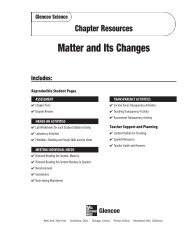Chapter 17: Invertebrate Animals
Chapter 17: Invertebrate Animals
Chapter 17: Invertebrate Animals
You also want an ePaper? Increase the reach of your titles
YUMPU automatically turns print PDFs into web optimized ePapers that Google loves.
What is an animal<br />
■ Identify the characteristics of<br />
animals.<br />
■ Differentiate between vertebrates<br />
and invertebrates.<br />
■ Explain how the symmetry of<br />
animals differs.<br />
All animals have characteristics<br />
in common.<br />
Review Vocabulary<br />
organelle: structure in the cytoplasm<br />
of a eukaryotic cell that<br />
can act as a storage site, process<br />
energy, move materials, or manufacture<br />
substances<br />
New Vocabulary<br />
• symmetry<br />
• invertebrate<br />
Figure 1 <strong>Animals</strong> come in<br />
a variety of shapes and sizes.<br />
Animal Characteristics<br />
If you asked ten people for a characteristic common to all<br />
animals, you might get ten different answers or a few repeated<br />
answers. Look at the animals in Figure 1. What are their common<br />
characteristics What makes an animal an animal<br />
1. <strong>Animals</strong> are many-celled organisms that are made of different<br />
kinds of cells. These cells might digest food, get rid of<br />
wastes, help in reproduction, or be part of systems that have<br />
these functions.<br />
2. Most animal cells have a nucleus and organelles. The nucleus<br />
and many organelles are surrounded by a membrane. This<br />
type of cell is called a eukaryotic (yew ker ee AH tihk) cell.<br />
3. <strong>Animals</strong> cannot make their own food. Some animals eat<br />
plants to supply their energy needs. Some animals eat other<br />
animals, and some eat both plants and animals.<br />
4. <strong>Animals</strong> digest their food. Large food particles are broken<br />
down into smaller substances that their cells can use.<br />
5. Most animals can move from place to place. They move to<br />
find food, shelter, and mates, and to escape from predators.<br />
Monarch butterflies<br />
in North America<br />
migrate up to<br />
5,000 km each year.<br />
The lion’s mane jellyfish can be<br />
found in the cold, arctic water and<br />
the warm water off the coasts of<br />
Florida and Mexico. Their tentacles<br />
can be up to 30 m long.<br />
The platypus lives in Australia. It is an<br />
egg-laying mammal.<br />
498 CHAPTER <strong>17</strong> <strong>Invertebrate</strong> <strong>Animals</strong><br />
(l)Fred Bravendam/Minden Pictures, (c)Scott Smith/<strong>Animals</strong> <strong>Animals</strong>, (r)Fritz Prenzel/<strong>Animals</strong> <strong>Animals</strong>














